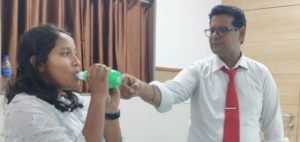Pulmonary Rehabilitation
What is pulmonary rehabilitation?
Pulmonary Rehabilitation is an evidence-based, multidisciplinary, and comprehensive intervention for patients with chronic respiratory diseases who are symptomatic and often have decreased daily life activities. Integrated into the individualized treatment of the patient, pulmonary rehabilitation is designed to reduce symptoms, optimize functional status, increase participation, and reduce health care costs through stabilizing or reversing systemic manifestations of the disease.”

Who can join the program?
Any patient with obstructive or restrictive lung disease whose activity of daily life is limited due to dyspnoea (Lack of breathing) can be referred for pulmonary rehabilitation.
Pulmonary rehabilitation can benefit those with:
- Chronic Obstructive Pulmonary Disease
- Chronic Bronchitis
- Emphysema
- Asthmatic Bronchitis
- Interstitial Lung Disease
- Other Pulmonary Diseases
What are the goals of this program?
All major pulmonary organisations such as the American College of Chest Physicians and the European Respiratory Society, recommend that pulmonary rehabilitation should be an integral part of the treatment program for all patients with reduced lung capacities like COPD and asthma. It should also be considered as a standard of care for patients with Interstitial Lung Disease.
The goals of pulmonary rehabilitation at SOLACE are:
- To reduce activity limitation and participation restriction.
- To restore patients to the highest possible level of independent functioning.
- To increase exercise tolerance and reduce the feeling of breathlessness.
- To restore the confidence to exercise safely and effectively within the limits of their chest problem.
